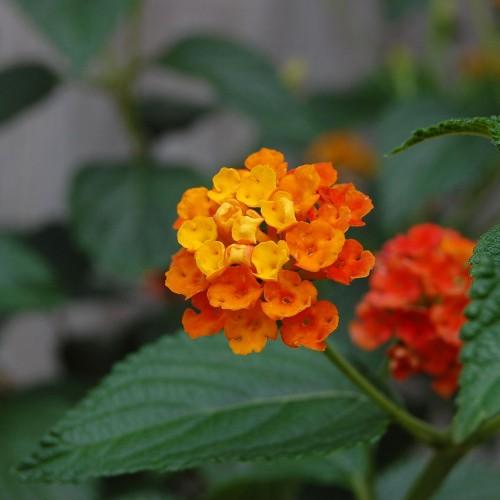
lantana
Lantana camara (incl. hybrids)
Cycle:
Perennial
Watering:
Frequent
Hardiness Zone:
9
Flowers:
Flowers In Summer
Sun:
full sun
Soil:
Well-drained
Fruits:
Fruits In Autumn Ready In Summer
Leaf:
Yes
Growth Rate:
High
Maintenance:
Moderate
Poisonous To Humans:
Yes
Poisonous To Pets:
Yes
Salt Tolerant:
Yes
Thorny:
Yes
Invasive:
Yes
Tropical:
Yes
Care Level:
Moderate
watering
Lantana is a tropical plant species that enjoys frequent watering to keep its soil lightly moist. During periods of active growth, water at least 2 to 3 times per week. When its leaves begin to wilt, it’s time to give the plant a good drink of water. During the winter months when the plant is dormant, water only when the soil begins to dry out.
sunlight
Lantana requires full sun, at least 8 hours of direct sunlight daily. If the plant does not receive enough direct sunlight daily, it will not perform well and may become leggy and look scraggly with fewer flowers. Nevertheless, it can tolerate light shade or partial shade if necessary.
pruning
When pruning, light trimming can be done at any time to improve the look of the plant or to control the size of the plant. Heavy pruning (more than 1-third of the plant’s growth) should only be done in late winter or early summer for best results. Additionally, deadheading (angled pruning to remove spent flower heads) should be done regularly to encourage continuous blooming. Removing spent flower heads also prevents lantana from self-seeding and invading other areas of your landscape.
FAQ
Is Lantana a perennial plant?
Yes, Lantana is a perennial plant. It grows to be between one and three feet tall and is known for its showy and fragrant flowers in colors such as yellow, orange, pink, and white. Lantana is drought-tolerant and typically blooms from mid-summer through the fall. It can tolerate partial shade but prefers full sun for the best blooms and foliage. Because of its hardy nature, Lantana is perfect for landscape borders, patio containers, and hanging baskets.
Could Lantanas be grown as a hedge?
Yes, lantanas can be grown as a hedge. Since lantanas have an mounding habit, as they mature they form a thick, dense hedge which makes them an ideal plant for hedges. Plant lantanas in well-draining, nutrient-rich soil and full sun. In addition, pruning them regularly can help to maintain the shape and the vigor of the hedge. The evergreen foliage also helps provide year-round appeal. Lantanas, however, are considered invasive in some areas, so check with your local Cooperative Extension for the most current information before planting.
Do Lantanas have a strong fragrance?
No, lantanas do not have a strong fragrance. The flowers are usually described as having a light, sweet scent that is most noticeable when smelled up close. Lantanas also attract butterflies and hummingbirds which may be able to appreciate the delicate fragrance more than a human.
Is Lantana considered an invasive species?
Yes, Lantana is considered an invasive species in many parts of the world. It is native to tropical regions in the Americas, but has been introduced to many other areas as an ornamental plant. In these new areas, Lantana can easily spread and out-compete native vegetation, leading to decreased species diversity. In some countries it is even listed as a noxious weed. In addition to impacting native species, the plant produces a toxin that can harm livestock and cause skin irritation in humans. As a result, it is important to take steps to remove and control Lantana to protect native ecosystems.
Could Lantanas be grown indoors?
Yes, lantanas can be grown indoors but they don't do as well as if they were grown outdoors. Artificial lighting will work for growing lantanas indoors but it should be kept in bright light for at least 4-6 hours each day for the best results. Also, be sure to keep the plants in a warm room and make sure they are properly watered. With a bit of effort, lantanas can be grown indoors and can even produce a few flowers.
Could Lantanas be used in butterfly gardens?
Yes, lantanas can be used in butterfly gardens. Not only do lantanas add a pop of colour to the garden, but they are also an important source of nectar for butterflies and other pollinators. Planting a variety of different lantana cultivars can help provide a steady food source for butterflies throughout the season. Lantanas come in a variety of shapes, sizes, and colours, and they require minimal upkeep. Planting a few of these tough, drought-tolerant plants in a sunny location can help create a stunning and beneficial butterfly garden.
Are Lantanas self-seeding plants?
Yes, lantanas are self-seeding plants. This means that when they flower and produce seeds, those seeds can take root and germinate into new plants. Lantanas are quick to reseed, meaning that you can expect an abundance of new seedlings in the spring after a successful flowering season in the summer. It's important to keep in mind, however, that these plants can be quite invasive and need to be kept from spreading too much. Picking off the flowers before they go to seed is the best method of controlling spread.
Could Lantanas be used in container gardens?
Yes, Lantanas can be used in container gardens! With their bright colors and easy-going nature, they are perfect to use as colorful focal points for a container garden. They prefer well-drained soils and need plenty of sunshine, so make sure the pot has good drainage and is exposed to full sun. They can also tolerate short dry spells, as long as the soil remains fairly moist. With their long blooming season and range of colors, they make a great addition to any container garden.
